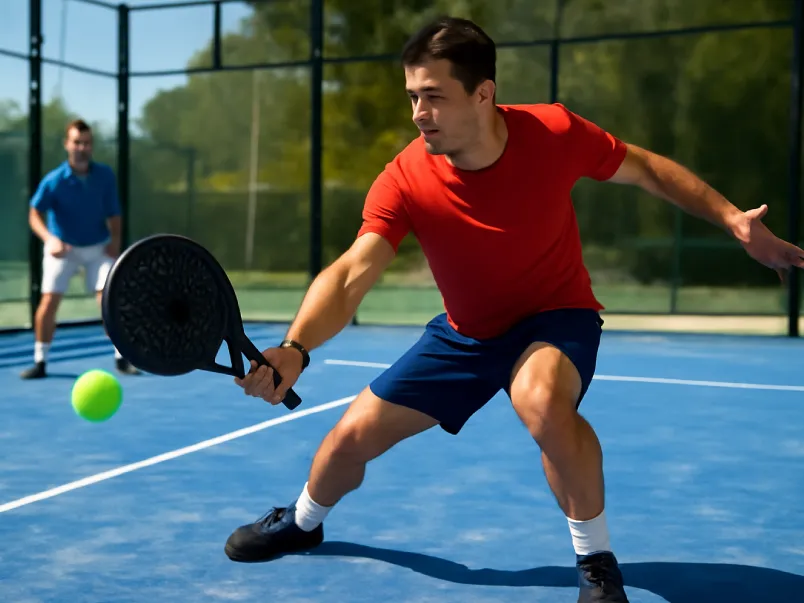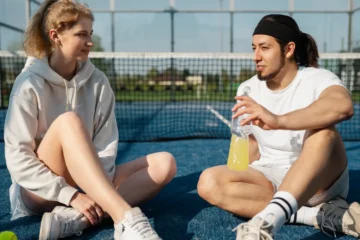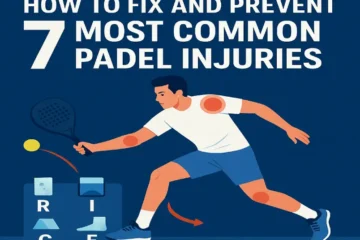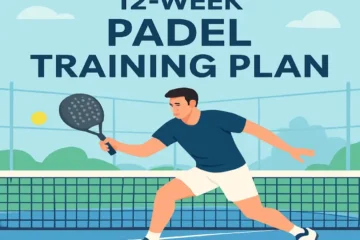Leveling Up Your Game
As a padel player, you’ve already crossed the threshold from beginner to intermediate—congratulations! You’ve spent the first six weeks of training developing essential skills like volleys, lobs, bandejas, and basic smashes. Now that you’ve built the engine, it’s time to fine-tune it for peak performance. This next phase will push you beyond the basics, integrating advanced techniques, refined tactics, and physical conditioning to elevate your game to a competitive level.
The Goal of This Phase
The goal of weeks 7-12 is to shift your focus from simply mastering individual techniques to utilizing them strategically in real-match situations. We’ll delve into high-level offensive and defensive strategies, introduce specialized shots, and focus on developing your mental toughness. You’ll also work on the physical aspects of padel to ensure you’re always in top form when you step onto the court.
Who This Plan Is For
This training plan is designed for players who are already comfortable with the fundamentals of padel and want to compete at a higher level. If you can consistently execute basic shots, but you’re now looking to refine your tactics and understand match dynamics, this plan will set you up for success. Whether you’re playing recreationally or looking to compete more seriously, this plan will elevate your game.
Brief Overview
For the next six weeks, we will focus on advanced tactics, specialized shots, physical conditioning, and mental toughness. Each week will feature a technical and tactical focus, paired with a physical conditioning regimen to help you build explosive power, agility, and endurance. By the end of this phase, you will have integrated these elements into a more complete and strategic approach to padel.
The Core Philosophy: The Four Pillars of Advanced Padel
Every training session from now on will focus on four key areas that together form the foundation for an advanced padel game.
1. Technical Precision
Now that you’ve learned the basic strokes, it’s time to refine them. You’ll work on mastering shots that add more versatility to your game, as well as learn advanced techniques like the Vibora, Chiquita, and smash variations. The goal is to improve the precision, consistency, and power of each shot so that you can use them effectively in real match situations.
2. Tactic & Strategy
Padel is not just about hitting the ball—it’s about thinking strategically. During this phase, you’ll learn how to read the game, develop offensive and defensive plans, and make smart decisions under pressure. You’ll also learn how to anticipate your opponent’s moves and create tactical patterns that will give you an edge.
3. Physical Conditioning
Padel requires explosive power, agility, endurance, and the ability to recover quickly between points. You will work on sport-specific fitness to enhance your physical performance, ensuring that you’re always in the best shape to move quickly, cover the court, and react to every shot.
4. Mental Fortitude
Mental toughness is often what separates good players from great ones. In this phase, you will develop a stronger mindset to handle pressure, stay focused during points, and manage your emotions during a match. You’ll learn strategies to maintain calm and stay resilient, especially when the match doesn’t go your way.
Week-by-Week Padel Training Plan
Week 7: Solidifying the Attack from the Net
Technical Focus: The Vibora
The Vibora, also known as the “snake shot,” is one of the most effective weapons in padel. Mastering the Vibora involves perfecting the grip, wrist action, and placement of the shot. This is an aggressive shot that is often used from the back of the court and can be a key to controlling the game when executed correctly.
Tactical Focus: Dominating the Net
As you move towards more advanced play, controlling the net becomes crucial. In doubles, especially, communication and movement are vital. You’ll work on poaching (taking a shot meant for your partner) and covering the court efficiently as a team. Understanding when to step in and take control of the net can shift the balance of a match.
Drill of the Week: “Cross-Court Vibora Drill”
In this drill, you’ll practice the Vibora shot from the left side of the court, targeting deep lobs. This exercise will help refine your shot placement and improve the consistency of your Vibora.
Physical Conditioning: Plyometric Exercises
For explosive power at the net, incorporate plyometric exercises like box jumps and lateral hops. These drills will help improve your vertical and lateral movement, key for reacting quickly to shots.
Week 8: Mastering the Art of Defense
Technical Focus: The Chiquita and Contrapared
The Chiquita is a soft, low return shot that is often played from the glass. The Contrapared, on the other hand, is a defensive shot that rebounds off the back wall. Both of these shots are essential for maintaining defensive pressure and keeping the rally alive.
Tactical Focus: Recovering Position
Knowing when to play a safe shot versus when to counter-attack is critical. In this week, you’ll focus on positioning and movement to recover quickly from defensive situations. Understanding how to transition from defense to offense will be key to staying competitive.
Drill of the Week: “Survival Drill”
In this drill, one pair is put under constant pressure at the net, while the other team works on defending and trying to win the point. This scenario will teach you how to manage defensive situations and recover quickly.
Physical Conditioning: Core Stability and Leg Endurance
Defensive shots require a strong core and legs. Focus on exercises like planks, leg extensions, and squats to maintain stability and strength in these key areas.
Week 9: Developing Your “Kill Shot” – The Smash
Technical Focus: The Smash and Bandeja
The smash is one of the most powerful weapons in padel. You’ll work on perfecting your footwork, contact point, and follow-through to make your smashes more aggressive and consistent. You’ll also focus on the bandeja, a slice shot that can be used when you want to maintain pressure on your opponent without going for an outright winner.
Tactical Focus: Shot Selection
Knowing when to use the smash for a winner and when to use the bandeja for placement is key. You’ll also work on handling high lobs and deciding when to let the ball bounce for an easier shot.
Drill of the Week: “Smash & Follow-Up”
This drill focuses on smashing the ball and then immediately preparing for the next shot, whether it’s a lob or a low return. This will help you stay alert and ready for whatever comes next.
Physical Conditioning: Rotational Power and Shoulder Strength
To execute a powerful smash, you need strong rotational power in your core and shoulders. Incorporate exercises like medicine ball slams and resistance band rotations to build strength in these areas.
Week 10: Deception and Unpredictability
Technical Focus: The Fake Shot and Drop Shot
The ability to deceive your opponent is a hallmark of an advanced player. You’ll work on faking shots (the “Amague”) to throw off your opponent’s timing and surprise them with a drop shot from the back of the court.
Tactical Focus: Breaking the Opponent’s Rhythm
Using deception and unpredictability will help you break your opponent’s rhythm. You’ll learn to use feints and disguise your intentions to open up the court and create opportunities for winners.
Drill of the Week: “Two-Option Drill”
In this drill, the player at the net must decide whether to hit a hard volley or a soft drop shot based on the feeder’s position. This will improve your ability to read the game and make quick decisions.
Physical Conditioning: High-Intensity Interval Training (HIIT)
HIIT exercises mimic the stop-start nature of padel points, helping you improve your cardiovascular fitness and recovery time between points.
Week 11: Advanced Doubles Strategy & Communication
Technical Focus: The X3 and Gancho
The X3 is an aggressive, dipping Vibora that forces your opponent to react quickly. The Gancho is a hook shot often used when the ball comes off the back wall. These advanced shots will give you more options in tight situations.
Tactical Focus: The Australian Formation and Team Strategies
This week focuses on advanced doubles strategies, including the Australian Formation and other serving/returning setups. You’ll learn to exploit your opponents’ weaknesses as a team, setting traps and creating pressure.
Drill of the Week: “Tactical Point Play”
Play full points, but with a specific tactical constraint (e.g., you can only win points by attacking the opponent’s backhand). This will help you work on exploiting specific weaknesses and improving teamwork.
Physical Conditioning: “Ghosting” Drills
Ghosting drills involve moving to shot positions without hitting a ball, mimicking the movement patterns you’ll use during a match. These drills improve footwork and court coverage.
Week 12: Integration & Match Simulation
Technical Focus: Shot Consistency Under Pressure
This week, we focus on integrating everything you’ve learned. You’ll work on shot consistency and fluidity under pressure, making sure that you’re able to execute each shot seamlessly during a match.
Tactical Focus: Full Match Simulation
You’ll simulate full match conditions, including pre-point rituals and between-point routines, to ensure you’re mentally prepared for real-game situations. This will help you stay focused and manage stress during competitive play.
Drill of the Week: “Pressure Cooker Match”
In this drill, you’ll play a set with specific scenarios, like starting at 0-30 or playing a 10-point tiebreak. These situations will help you practice handling match pressure.
Physical Conditioning: Active Recovery and Mobility Work
Focus on recovery and flexibility to ensure you’re in peak physical condition for match play. Stretching, yoga, and mobility exercises will help you stay limber and avoid injury.
The Supporting Cast: Essential Elements for Success
Warm-Up & Cool-Down Routines
Start each training session with dynamic stretching to prepare your muscles for action. Post-training, spend time on static stretching to increase flexibility and aid in recovery.
Nutrition & Hydration
Proper nutrition and hydration are key to your performance. Be sure to fuel your body before and after training, focusing on balanced meals that support energy levels and muscle recovery.
Rest & Recovery
Never underestimate the importance of rest. Make sure to get adequate sleep and take rest days between sessions to allow your muscles to recover and grow stronger.
Equipment Check
As your skills evolve, ensure that your paddle and shoes are suited to your playing style. A proper racket and good court shoes can make a significant difference in your performance.
Conclusion: You Are Now a Complete Padel Player
Congratulations! You’ve successfully navigated through a comprehensive training program that has taken you from a solid foundation to an advanced, tactical approach to padel. You’ve integrated technical precision, strategic thinking, physical conditioning, and mental fortitude into your game, giving you the tools to compete at a high level.
The Path Forward
Remember, improvement doesn’t stop here. Continue playing against stronger opponents, analyze professional matches, and always look for ways to enhance your game.
Final Motivational Push
“You have the tools. Now go out there, trust your training, and dominate the court!”
FAQs
1. What is padel?
Padel is a fast-paced, doubles-oriented sport that combines elements of tennis and squash. Played with solid rackets and a ball, the game is typically played on an enclosed court where the ball can bounce off the walls, making it both strategic and fun.
2. Who is this 6-week padel training plan for?
This training plan is designed for intermediate players who have mastered the basics of padel and want to progress to more advanced tactics and techniques. It’s ideal for those looking to compete at a higher level or refine their skills for strategic play.
3. How can I improve my shot accuracy in padel?
To improve shot accuracy, focus on perfecting your grip, footwork, and follow-through. Practicing specific shots like the Vibora, smash, and bandeja will help increase both your precision and consistency on the court.
4. What physical conditioning exercises should I include in my padel training?
Incorporate exercises that improve power, agility, and endurance, such as plyometric exercises, HIIT (High-Intensity Interval Training), and core strength routines. These will help enhance your speed, reaction time, and recovery between points.
5. How important is mental fortitude in padel?
Mental fortitude is critical in padel as it helps you stay focused, resilient, and calm under pressure. Developing a strong mental game will allow you to recover from mistakes quickly, stay composed during intense moments, and maintain consistent performance.
6. What are the best doubles strategies in padel?
Effective doubles strategies include controlling the net, using the Australian Formation, and communicating well with your partner. Learn to exploit your opponent’s weaknesses, move in sync with your partner, and anticipate their shots to stay one step ahead.
7. How do I know when to use advanced shots like the Vibora and Bandeja?
The Vibora is perfect for hitting deep shots with power, while the Bandeja is a slice shot ideal for maintaining pressure. Learn to use the Vibora when you’re attacking from the back and the Bandeja when you need to control the rally while keeping your opponent on the defensive.
8. What is the importance of rest and recovery in padel training?
Rest and recovery are essential for muscle repair, mental focus, and preventing injuries. Be sure to incorporate rest days into your training schedule and get enough sleep to maximize the benefits of your workouts.




